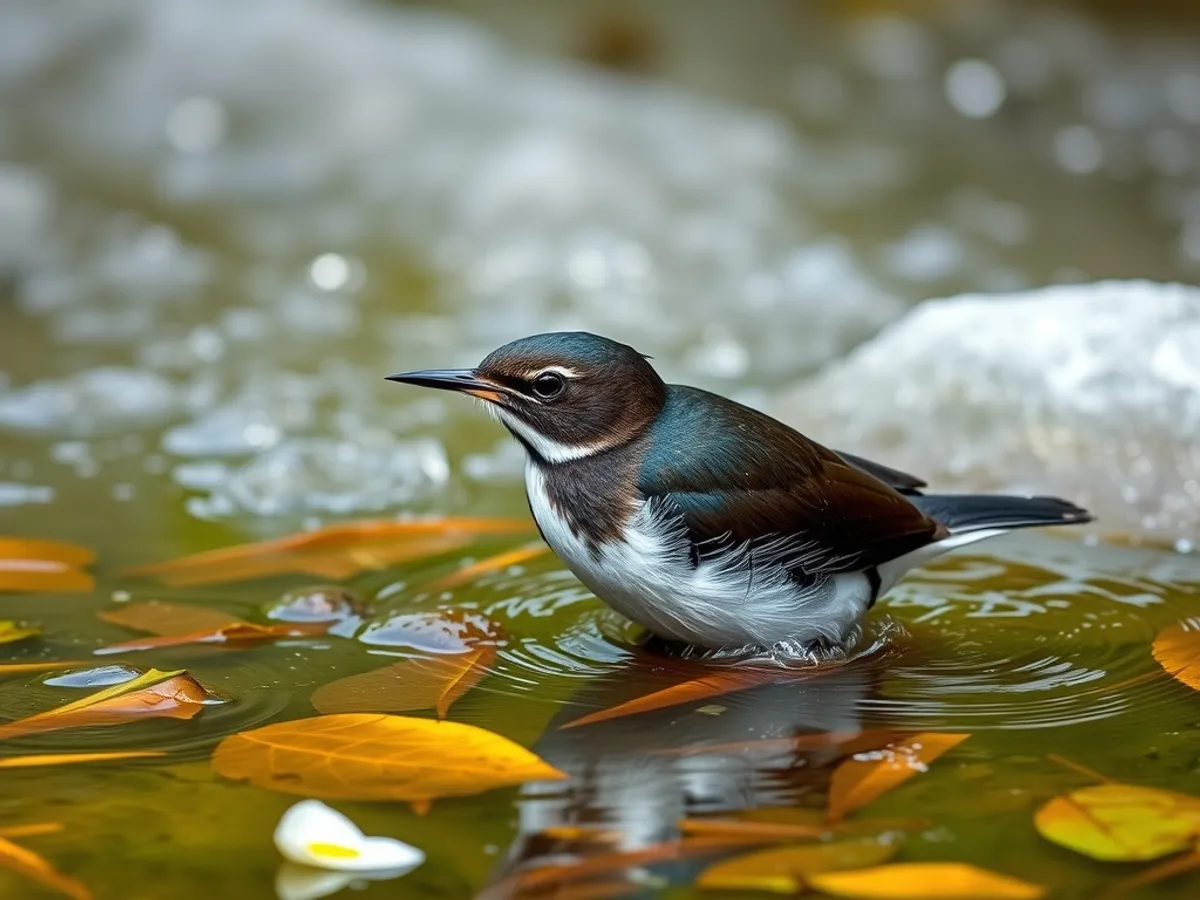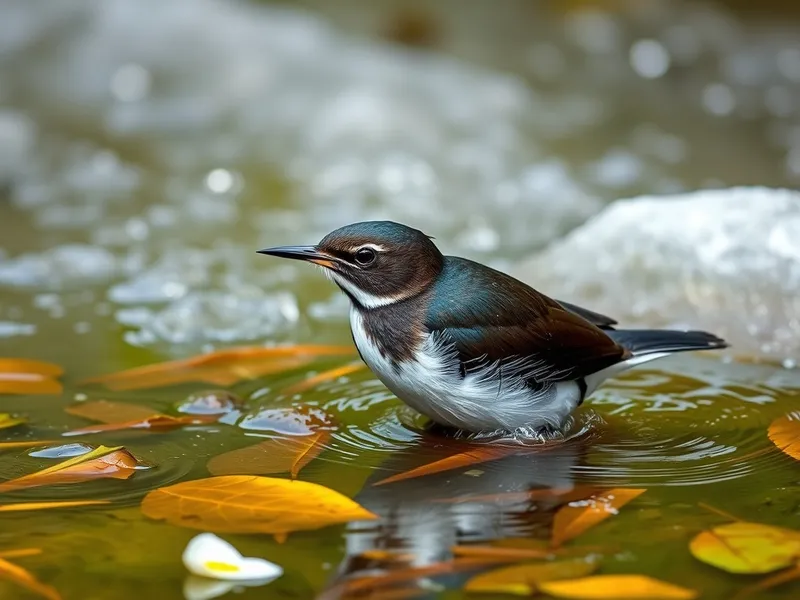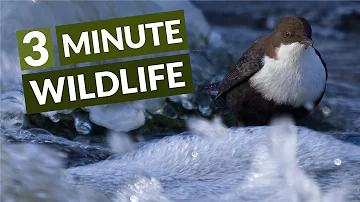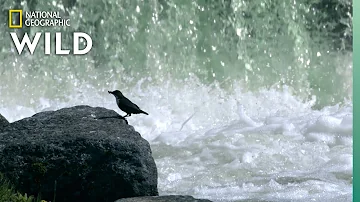
White-throated Dipper
Cinclus cinclus

Meet the White-throated Dipper
The White-throated Dipper is a small, robust bird renowned for its striking white throat and chest, which contrast sharply with its dark brown-black plumage. It is commonly found near fast-flowing streams and rivers across Europe, the Middle East, and Central Asia, where it forages for aquatic invertebrates. Unlike most songbirds, the dipper is highly adapted to life in and around water, often walking and even swimming underwater using its wings to search for food. Its energetic bobbing movements on rocks and riverbanks are characteristic behaviors, giving the bird its 'dipper' name.
Classification
Bird
Habitat
Fast-flowing freshwater rivers and streams
Diet
Carnivore
Lifespan
5-8 years
Conservation
Least Concern
Weight
46–70 g
📖Fascinating Facts
Expert Swimmer
The White-throated Dipper is one of the few songbirds able to walk and swim underwater, using its wings to propel itself while hunting for aquatic prey.
Distinctive Song
Despite living near noisy streams, the dipper has a loud, melodious song that can be heard over the rushing water, especially during courtship.
Unique Nesting Habits
Dippers often build their mossy, domed nests on rocks or ledges directly over water, ensuring easy access to their main food source and added protection from predators.
📋Detailed Description
The White-throated Dipper (Cinclus cinclus) is a medium-sized passerine, measuring 17–20 cm in length with a wingspan of 25–30 cm and weighing between 46–70 grams. It is robust and compact, with short, rounded wings and a relatively short tail. The most distinctive feature is its bright white throat and upper breast, sharply contrasting with its otherwise dark brown to slate-black plumage; some subspecies exhibit a chestnut-colored belly band. The bird's legs are strong and adapted for perching on slippery rocks, while its bill is straight and slender, ideal for probing underwater. The dipper's eyes are positioned to allow excellent vision both above and below water, aided by a nictitating membrane that protects the eyes while submerged. Its dense, waterproof plumage and a large preen gland help maintain insulation and buoyancy. The species is highly territorial, especially during the breeding season, and is often observed alone or in pairs. It is renowned for its characteristic bobbing or 'dipping' motion, which may serve as a visual signal in the noisy environments it inhabits. The White-throated Dipper is an accomplished diver and swimmer, using its wings to propel itself underwater in search of prey. Its song, a loud, melodious warble, is audible even over the sound of rushing water.
💡 Did you know?
Unlike most songbirds, the White-throated Dipper has a special membrane that covers its eyes when submerged, allowing it to see clearly underwater.
🔬Research & Sources
Wikipedia Summary
The white-throated dipper, also known as the European dipper or just dipper, is an aquatic passerine bird found in Europe, Middle East, Central Asia and the Indian Subcontinent. The species is divided into several subspecies, based primarily on colour differences, particularly of the pectoral band.
Last Modified: 6/7/2025
🎭Behavior & Social Structure
White-throated Dippers are diurnal and primarily solitary outside of the breeding season, defending linear territories along stretches of rivers or streams. They spend much of their time perched on rocks or low branches near water, frequently dipping or bobbing their bodies. Feeding behavior is highly specialized: dippers walk or swim underwater, using their wings for propulsion and their strong toes to grip the substrate, as they search for aquatic invertebrates such as insect larvae (especially caddisflies, mayflies, and stoneflies), small crustaceans, and occasionally small fish or amphibians. They may also forage along the water's edge for terrestrial invertebrates. Dippers are known for their agility in fast-flowing water, often diving into turbulent streams where few other birds can forage. Social interactions are generally limited to courtship and parental care, with pairs engaging in mutual preening and duet singing during the breeding season. Daily routines include regular preening to maintain waterproof plumage, frequent feeding bouts, and territorial patrols.
👶Reproduction & Life Cycle
Breeding occurs from March to July, with timing varying by latitude and altitude. Pairs are monogamous within a breeding season, and territories are vigorously defended. The nest is a large, domed structure made of moss, grass, and leaves, typically built in crevices on riverbanks, under bridges, or behind waterfalls, always close to water. The female lays 4–6 white eggs, which she incubates alone for 16–18 days. After hatching, both parents feed the chicks a diet rich in aquatic invertebrates. The nestlings fledge at about 18–24 days old but may remain dependent on the parents for up to two weeks post-fledging. In favorable conditions, pairs may raise two broods per season. High nest-site fidelity is observed, with pairs often returning to the same nesting location in successive years.
🛡️Adaptations & Survival
The White-throated Dipper exhibits several remarkable adaptations for its aquatic lifestyle. Its dense, waterproof plumage and enlarged uropygial (preen) gland ensure insulation and buoyancy in cold water. The bird's blood has a high concentration of hemoglobin, allowing efficient oxygen storage for extended dives (up to 30 seconds underwater). Specialized muscles and tendons in the legs and feet provide a strong grip on slippery rocks. The nictitating membrane protects the eyes underwater, while the nostrils can close to prevent water ingress. Behavioral adaptations include the characteristic dipping motion, which may help dislodge prey or serve as a territorial signal. The dipper's song is adapted to be heard over the noise of running water, and its cryptic coloration provides camouflage among rocks and shadows.
🎨Cultural Significance
The White-throated Dipper holds a special place in the folklore and culture of many European countries. It is the national bird of Norway and features in Scandinavian literature and poetry as a symbol of resilience and purity. In the British Isles, it is often associated with clean, unspoiled rivers and is considered an indicator of healthy aquatic ecosystems. The dipper's energetic presence and distinctive song have inspired naturalists and artists alike. In some traditions, it is believed to bring good luck to fishermen or to herald the coming of spring.
🔬Recent Research & Discoveries
Recent research has focused on the dipper's role as a bioindicator of freshwater ecosystem health, with studies correlating dipper population trends to water quality and invertebrate abundance. Advances in tracking technology have revealed detailed patterns of territory use and dispersal, highlighting the importance of river connectivity. Genetic studies have clarified the relationships among the 14 recognized subspecies, showing adaptations to local environmental conditions. Ongoing research is examining the impact of climate change on breeding phenology and prey availability, as well as the effects of microplastic pollution on aquatic food webs and dipper health.
🎥Wildlife Videos

Exploring White-Throated Dippers | Short Nature Documentary
Learn all you need to know about the white-throated dipper in under 3 minutes! 📽️ A longer video of this bird, and the journey to ...
Nature by Niklas NW

Nesting birds – White-throated dipper (Cinclus cinclus)
Let's start a little sentimental today. For me and my wife, the white-throated dipper is the symbol of our relationship. When Petra ...
European Wildlife by Lukáš Pich

Birds "Fly" Through Water For Food | Wild Nordic
#NatGeoWILD #Birds #WildNordic About National Geographic Wild: National Geographic Wild is a place for all things animals ...
Nat Geo Animals

Follow your way a movie about the White throated Dipper
Full movie in english - Follow your way - A film about the white-throated Dipper by Yannick Alram.
Yannick Alram Nature

White-Throated Dipper Species Guide: Appearance, Diet, Habitat, Behavior, Stats, And Conservation
This video is everything you need to know about the White-Throated Dipper (Cinclus cinclus) Adult White-Throated Dippers are ...
In Focus

4K-Amazing White Throated Dipper - Winter river in Finland - Nature Video & Photos - Relaxing Music
Amazing White-Throated Dipper Not afraid of cold water and swims with his wings. Dives its food from the bottom of flowing rivers ...
JS NatureRocker Films
🌍Habitat Information
The White-throated Dipper typically inhabits Fast-flowing freshwater rivers and streams environments. White-throated Dippers have adapted to their environments with specialized features and behaviors.
Primary Habitat:
Fast-flowing freshwater rivers and streams
More detailed habitat information will be available soon.
🛡️Conservation Status
The White-throated Dipper is currently classified as Least Concern. Conservation efforts are crucial for preserving this species for future generations.
Common Threats:
- 🏠Habitat loss and fragmentation
- 🌡️Climate change impacts
- 🎯Hunting and poaching
- 🏭Human-wildlife conflict
⚠️Threats & Conservation Challenges
While the White-throated Dipper is currently listed as Least Concern by the IUCN, local populations face several threats. Water pollution (especially from agricultural runoff and industrial waste) can reduce prey availability and degrade nesting sites. River regulation, damming, and channelization alter natural flow regimes, impacting habitat quality. Disturbance from recreational activities and infrastructure development (such as bridge construction) can disrupt breeding. In some regions, harsh winters or droughts may cause temporary declines in numbers. Despite these challenges, the species remains widespread and adaptable, with stable or increasing populations in many parts of its range, partly due to improved water quality in recent decades.
🔬Scientific Classification
Scientific Name
Cinclus cinclus
Classification Hierarchy
🔍 About Taxonomic Classification
Taxonomic classification is a hierarchical system used by scientists to classify and organize living organisms based on shared characteristics and evolutionary relationships.
The system moves from broad categories (Kingdom) to increasingly specific ones, with each animal's scientific name typically consisting of its Genus and species.
📝Community Notes
Share your observations and insights about the White-throated Dipper with our community of wildlife enthusiasts.
Join Our Community
Sign in to share your observations and connect with fellow wildlife enthusiasts.
Sign In to ContributeNo community notes yet
Be the first to share your observations about the White-throated Dipper!
Explore White-throated Dipper
Select a tab above to learn more about this amazing animal.
📸Photo Gallery
No photos available for this animal yet.
🌟Discover More Wildlife
Continue your journey of discovery with more fascinating animals from our database
